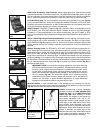
Observing a Satellite
NOTE: Satellite observing is an exciting challenge. Most satellites are in low orbit,
traveling at approximately 17,500 mph. They move quickly across the sky and are
visible only for a few minutes, requiring Autostar to slew the telescope rapidly. Best
viewing is near Sunrise or Sunset when the sky is still dark. Viewing in the middle
of the night can be problematic because the satellite may pass overhead, but not
be visible as it is in the Earth's shadow.
1. Choose a satellite from the Select menu, then press ENTER. Autostar scans its database
to find if that satellite is expected to pass overhead within the next 6 hours.
2. If a satellite is expected, use the Scroll keys to access a list of information about the pass,
including acquisition time, location,
etc.
3. At the end of the list is “Alarm.” Press ENTER and Autostar automatically sets the alarm to
sound several minutes before the scheduled appearance. You may return to regular obser-
vations until the alarm goes off.
4. When the alarm goes off, return to the Satellite menu and press a Scroll key until the
desired satellite is on the top line of the display.
5. Press GO TO. Autostar slews the telescope to where the satellite should appear. The motor
drive stops and a countdown starts.
NOTE: If the scheduled appearance position of the satellite is obstructed (i.e., by a
building, tree, or hill), press ENTER and Autostar starts to move the telescope
along the expected satellite track. When the track clears the obstruction, press
ENTER again to pause the telescope, then continue with this procedure.
6. With about 20 seconds left on the countdown timer, start watching through the eyepiece
for the satellite to enter the field of view.
7. When the satellite enters the field of view, press ENTER. The telescope starts to track with
the satellite.
8. Use the Arrow keys to center the object in the eyepiece to view the object. Satellite orbits
change and new satellites (including the Space Shuttle) are launched. Visit the Meade
website (
www.meade.com) approximately once a month to get updated information and
instructions on how to download this data to Autostar. If orbital parameters are more than
one month old, the satellite pass may not happen at the time predicted by Autostar. To
download new satellite data into Autostar memory requires the optional Astrofinder
Software and Cable Connector Kit. See “OPTIONAL ACCESSORIES,” page 25.
Photography with the ETX
Photography through the ETX-60AT or ETX-70AT requires the addition of the optional #64ST
T–Adapter. See “OPTIONAL ACCESSORIES,” page 25. With the #64ST T-Adapter attached to
the telescope (
Fig. 17), through-the-telescope photography is possible with any 35mm camera
body with a removable lens. In this way, the telescope effectively becomes the lens of the camera.
For through-the-telescope photography, turn the flip-mirror control (15, Fig. 1) to the “down”
position, allowing light to pass straight through the telescope and out the photo port (
16, Fig. 1).
With the flip-mirror control in the “down” position and the photo port’s dust cover removed, the
front lens of the telescope can be seen when looking through the photo port. The #64ST T-
Adapter (1, Fig. 17) threads on to the photo port, followed by a T-Mount (2, Fig. 17) for the par-
ticular brand of 35mm camera being used, followed by the camera body (
3, Fig. 17).
To frame an object in the viewfinder of the 35mm camera body, use a small jeweler’s screw-
driver to slightly loosen three adjustment screws (4, Fig. 17) around the outer knurled ring of
the T-Mount. Rotate the camera body to achieve proper framing of the object; then re-tighten
the adjustment screws.
Advanced Features 23


















